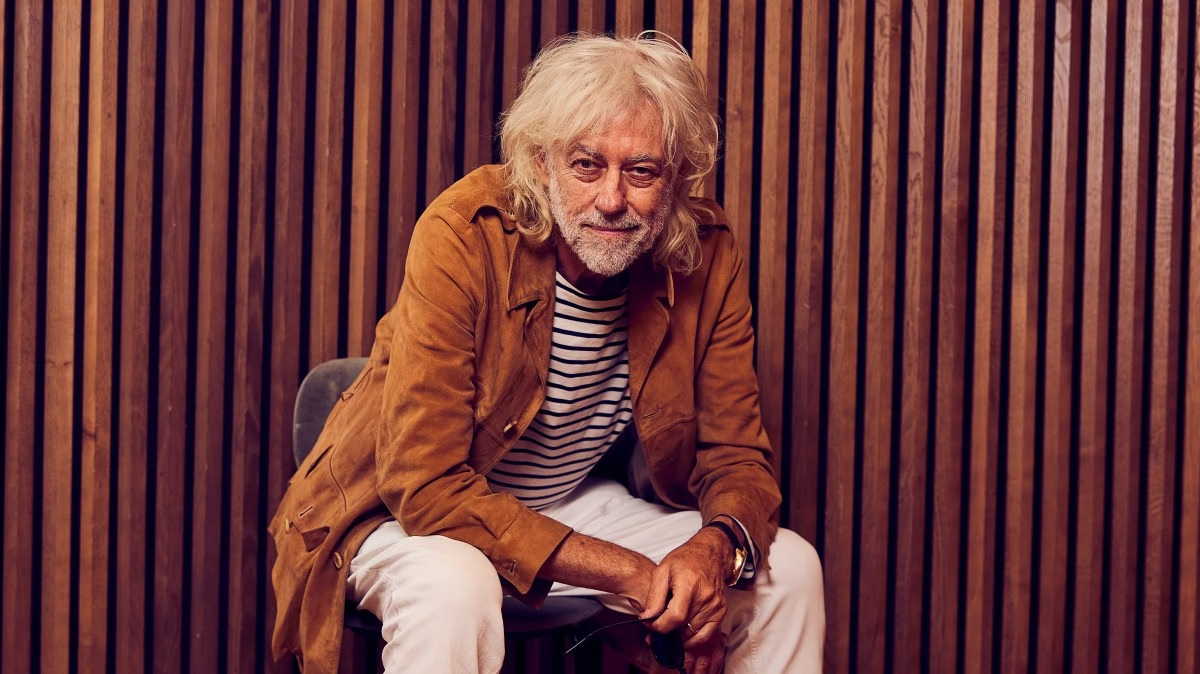At 73, Bob Geldof still looks very much the rock star in his leather jacket, shades and unruly mop of hair, now entirely grey. This coming Halloween, his band the Boomtown Rats, formed in his native Dun Laoghaire, south Dublin, will celebrate their 50th (albeit with a long break) anniversary with a tour. His status as an international aid activist, however, has long eclipsed his late Seventies success as a musician, and we’re meeting at Bafta, in Piccadilly, to talk about another anniversary.
On July 13 it will be 40 years since the Live Aid gigs in London and Philadelphia, Geldof’s follow-up to the Band Aid single he had co-written and co-ordinated the previous Christmas. That had been a response to reading Paul Vallely’s reports in The Times, and seeing Michael Buerk’s coverage for the BBC, of the devastating famine in northern Ethiopia. The BBC has now made three hour-long documentaries, about Band Aid, Live Aid and its 2005 successor, Live 8. Geldof is at Bafta to watch the second film and speak about it afterwards. I learn in a later phone call that he was not happy with some of the content.
Bob Geldof in Ethiopia in 1985
SHUTTERSTOCK
In the first film Geldof describes the “shame and rage” he felt on seeing the pictures of young children starving to death “in this world of plenty”. It will surprise no one to learn that four decades on, the rage is undimmed. Despite stiff competition in a nation famed for its passion and eloquence, Geldof would still merit selection to talk for Ireland. His conversation is, as we know, urgent, profane and colourful. He is a very bright man with an acute memory and a world-class contacts book, able to access pretty much anyone he thinks can help his cause. A sophisticated campaigner, Geldof is also, which is perhaps less acknowledged, an arch-pragmatist, working across politics to raise money and effect change. “No business is more ruthlessly focused on the bottom line,” he tells me, “than rock and roll.”
• Tony Blair: Bono and Geldof saved millions of lives with Live Aid
For instance, he gives short shrift to critics of Live Aid for not featuring many black artists. There were a fair few African-Americans on stage in Philadelphia but only Sade featured at Wembley. “The line-up was about getting people who sold millions of records so we could raise millions of pounds. That was my sole criterion when I asked people. There weren’t black artists in Britain at that time selling big numbers.”
Geldof speaks highly of Andrew Mitchell, the Conservative minister of state for development and Africa, and his former boss, David Cameron, who as prime minister took UK overseas aid spending to 0.7 per cent of GDP. “Cameron was given the day off from Eton to watch Live Aid. He told me it had influenced a generation. And when I sold my TV company Planet 24 to Michael Green, his PR was a young David Cameron, so I knew him.”
He remains in touch with George W Bush, the former Republican president who gave money to combat HIV/Aids in Africa after being lobbied by the Bob and Bono double act. Bush appears in the third documentary, chuckling that “Geldof looked like somebody who’d crawled out from under the ground”.
Another indication of Geldof’s realism is that he is less scathing than might be supposed about Labour’s cuts to the aid budget to fund defence spending. “Without any question, we need to rearm now. Not in f***ing 2029. Now. Our continent is being invaded now by an arch-thug [Putin]. So that’s first.” He also recognises these are grim, ungenerous, pull-up-the-drawbridge times, far different from 2005, the pinnacle of his activism, when after many years of global economic growth the G8 Gleneagles summit agreed to partial debt cancellation and expanded aid for poor countries, thanks in part to 20 years of lobbying by campaigners like Geldof.
George Michael, Geldof and Bono at Live Aid
DUNCAN RABAN/POPPERFOTO VIA GETTY IMAGES
“Politics does what it’s allowed to do by where society is at. People are very afraid at the moment, there’s been a cultural shift. That allows Trump’s mayhem on February 1. When Musk just pulled the plug on the USAID websites, instantly 10,000 USAID workers around the world were in serious danger. That allowed everyone else to say ‘times are tough’. It’s the brute politics of now. So all of this hoopla around this anniversary is frankly odd for me.”
Even so, there is no limit to hoopla about Live Aid that someone my age (I was just shy of 21 in July 1985) is willing to hear. Geldof, showman that he is, duly obliges. Part of his critique of the documentary is that it did not include enough footage of the actual music, in London and Philadelphia, given that the standard was so high. “Why is it remembered so vividly? Because of the link-up with America, and because people felt part of something bigger, but also because it was such a great concert. I don’t think the film captured the glory of that.”
• Daniel Finkelstein: Band Aid’s critics are just feeding cynicism
The other factor, I suggest, was that Live Aid was the first time the pop demographic, which in 1985 still largely meant people under the age of 30, had seen Paul McCartney playing Beatles songs. Nowadays, Macca trooping on stage flashing peace signs to close out a big event with Hey Jude or Let It Be is commonplace. In 1985 it was a revelation. “It was his first time on stage since John died. Linda, Stella and the kids persuaded him to do it. He was driving up from Sussex, listening to U2 on the radio, and they were so good, he was getting really nervous, especially because once he’d said yes, given the hierarchy in pop, with the Beatles unassailable at the top, he had the added burden of closing the show.
“Paul asked me which song he should do and I said Let It Be, because it’s a benediction. Then his mic fails and Pete Townshend [Geldof had bounced the Who into appearing by announcing on TV that they were reforming, which was news to them] grabs me from one side and says, ‘Let’s help him,’ and David Bowie grabs me from the other, and with Alison [Moyet] we went out to sing along.”
David Bowie, Alison Moyet, Pete Townshend, Geldof and Paul McCartney at Live Aid
STEVE RAPPORT/GETTY IMAGES
McCartney was not the only nervous superstar that night. “David Bowie was literally trembling at the side of the stage before his set. Really scared. We were watching the viewing figures and becoming aware of the sheer size of the audience [close to two billion].” Before his performance, earlier on, Geldof had lain on the floor backstage to stretch out his painful back. “David [Bowie] came by and said, ‘What’s the matter?’ I told him and he said, ‘Roll over,’ and started massaging me. I’m saying, ‘Bit further down, mate,’ to David f***ing Bowie!”
Geldof doesn’t want to be overly critical of the latest documentary. “But there were too many redundant DJs from the 1980s and some great performances not seen. Elvis Costello riffing on All You Need Is Love, Elton John and George Michael. I don’t want to sound self-aggrandising but it was a fabulous gig. And it said, ‘Change is possible, there is such a thing as society and for once in our lives, something can work.’” And, as Tony Blair says in the third episode, thanks to Band Aid and Live Aid, “millions of people are alive today who otherwise wouldn’t be”.
A ticket to Live Aid at Wembley Stadium
ALAMY
Geldof still spends at least an hour a day, every day, “including Sundays”, on his role as chair, and one of six trustees, of the Band Aid Charitable Trust. Midge Ure, his co-founder, is another trustee, as is Harvey Goldsmith, who promoted Live Aid. That morning, he had listened to a brief about Somalia from a group asking for $80,000 to remove thousands of goitres [lumps in the neck] caused by iodine deficiency. “It’s amazing how much you can help with comparatively small amounts of money.”
One section of the film that impressed me, I say, is how he knew right from the outset that if he went to Ethiopia after the success of Band Aid he would face criticism. The term “white saviour complex” had yet to be coined in early 1985, when Geldof went to the refugee camps in Tigray, but that is what he was accused of having, then and since. He went because Ken Lennox, the veteran tabloid photographer and a neighbour in London, came round and told him he had to go for the famine to stay in the media spotlight. “This white saviour thing is bollocks,” he says succinctly. “It comes from all that 1968 Derrida/Foucault language bollocks. It’s nonsense.
“I understood the argument. I was a late 20th-century creature of the media. I’m only in Africa because of television and some guy writing in The Times. The media came to me and said, ‘When are you going to Africa?’ I said, ‘What are you talking about?’ They said, ‘You have to go.’ And I said, ‘Why?’ And they said, ‘Because you’re the f***ing story’.
“And I said, ‘I’m not the story. People are f***ing dying of no food in a world of surplus food, that’s the story.’ And they said, ‘We can’t keep doing the starving child, the starving mother, we’ve done it, Bob.’” So off he went. That was the moment when the course of his last 40 years was set.
Princess Diana, Prince Charles, Geldof and Paula Yates
ALAMY
What Geldof is seeking, he says, is “a new rhetoric” to get development back up the agenda. “For years Britain led the way, the gold standard, soft power in excelsis.” He thinks one way to address concerns is to tackle concerns over immigration. “What people want to do is stop a thousand people arriving each day on the boats. Fair enough. But Africa is the one continent of population growth. Look at Nigeria: about 240 million people now, the UN says it’ll be 350 million by 2050. And those people currently aren’t able to find work in the countries where they are. They are going to come.
“Nobody really wants to cross mountains and deserts or get in a rubber tube and try and get across the sea. So we shouldn’t dodge this issue. We should say if we help build an economy at the very basic level of health, education and agriculture, and then invest in those economies, it will be good for Britain. It sounds pious and lefty, but it’s evidence-based.”
This is the essence and appeal of Geldof. So often patronised as a “give us yer fecking money!” (which he didn’t actually say) rabble-rouser, he is in fact a deeply realistic, gradualist, coalition-building expert.
He finishes by urging me to go and see Just for One Day, the musical based on Live Aid running in the West End. “It’s a laugh, the music is insane, it’s a cartoon and the poor f***er who has to play me, he’s a Scouser, he’s 6ft 4in, but unbelievably his party piece when he was nine years old, his granny used to make him get up on the kitchen table and do Bob Geldof.” And yes, the real thing is anything but inimitable, yet he is a very special man all the same.
Live Aid at 40: When Rock’n’Roll Took on the World starts on Sunday, July 6 on BBC2 at 9pm
Live Aid turns 40: tell us your best story
Set the scene, where were you and how old were you? Then tell us what happened.
Please share your response with us in a voice message on WhatsApp. You can reach us at +44 (0)7353096428









Leave a Reply